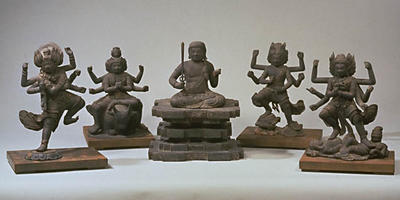:::::::::::::::::::::::::::::::::::::::::::::::::::::::::::::::::::::::::::::::::::::::::::::::::::::::::::::::::::::::::::
daiza 台座 seat of Fudo Myo-O 不動明王
A pedestal or dais upon which the statue of a Buddhist deity is placed.

Lotus Seat, Rengeza 蓮華座
. Daiza, the Seat of Buddha 台座 .
- Introduction -
:::::::::::::::::::::::::::::::::::::::::::::::::::::::::::::::::::::::::::::::::::::::::::::::::::::::::::::::::::::::::::
banjakuza, iwaza, ganza 盤石座, 岩座
stone pedestal
Sometimes figures of demons are engraved in the stone.
banjaku 盤石 means "it does not move"

source : kyobibutsuzou.com
Felssockel (banjakuza, iwaza, ganza)
Sockel in Form natürlicher Felsen.
Fast ausschließlich für Myo-O, Ten oder noch niederere Gottheiten mit furchterregendem Gesichtsausdruck. Auf dem Stein können sich auch noch Dämonen-Figuren befinden, auf denen die Myo-O trampeln. Siehe Dämonensockel.

source : shunjudo.cocolog-nifty.com
His waistcloth is wrapped separately around each let, so he is able to step out and help people any time.

source : uemasazouen38.com - Uemasa 【植雅造園】
護摩堂裏手に不動明王像の岩座
奈良の石を使って瑟瑟座(しつしつざ)をイメージしています.
.......................................................................
fumiwari rengeza 踏割蓮華座
lotus base with separate feet
..... fumiwake rengeza 踏分蓮華座
Mostly for standing statues of Amida Nyorai, sometimes Fudo Myo-O.

Schritt-Sockel (fumiwariza, fumiwari renza 踏み割り座)
Zwei kleine Lotussockel unter jedem Fuß einer stehenden bzw. "laufenden" Figur. Häufig für Myo-O, selten auch bei Amida Nyorai.
. hashiri Fudo 走り不動 "running Fudo" .
.......................................................................
shitsushitsuza 瑟瑟座
gem or precious stone base, "Diamond Seat"
The most common base for an image of Fudo Myo-O 不動明王, especially in a group with four others, godai myoo-o 五大明王.

source : kyobibutsuzou.com

source : komyoin.free.fr
Erhabener Sockel (shitsushitsuza)
"Edelsteinsitz".
Mehrstufiger, eckiger Sockel eines Myo-O. Ein fester Sockel aus mehreren, unregelmäßig geschichteten Brettern. Meist bunt bemalt. Eine abstrakte Form des Felssockels. Häufig bei einem Fudoo Myo-O, wenn er die mittlere Figur einer Gruppe der fünf großen Myo-O bildet.
:::::::::::::::::::::::::::::::::::::::::::::::::::::::::::::::::::::::::::::::::::::::::::::::::::::::::::::::::::::::::::
daibanjaku 大盤石/大磐石 "huge rock"
Sometimes a statue of Fudo sits on a huge rock,
at other places a huge rock itself is venerated as Fudo Myo-O himself.

source : myacyouen-hitorigoto
岩座(いわくら)の不動明王
. Fudo-Iwa 不動岩 Fudo Rock formations .
.......................................................................
苦難に耐えれば開ける希望 - 盤石(ばんじゃく)の決意 - banjaku
If you withstand the difficulties in life, hope will come
. nana seigan 七誓願 Seven Sincere Vows .

「私たちの誓い」- 大磐石に坐すお不動さまのように、常に冷静で、何事にも動じることのない不動心の体得に努めなさいという御教えです。
お不動さまがお坐りになっている磐石は、さとりを求める清らかな心の不動性とすべての人々を余すことなく救済するという決意を表しています。
何事にも動じない堅固な決意をもって進んだ先には、必ず未来が開け、大きな希望が見えてきます。
- source : naritasan.or.jp -
. fudooshin 不動心 The Immovable Spirit .
.......................................................................

. Ootokuji 王徳寺 Otoku-Ji . - Nagano
大盤石に坐した忿怒のお不動さま
.......................................................................

不動明王像 - 信海筆
Shinkai, painter of the Kamakura period
. Daigoji 醍醐寺 Daigo-Ji .
.......................................................................
動かざること大磐石の如し
It is immovable as the living rock ― firm as a rock
banjaku does not only mean "not to move"
but also "to bring forth good fortune and riches"
.......................................................................
- quote
Ishikozume Ritual Execution in Japanese Religion
..... they dig a deep, square hole, placing in the middle of it a stone called banjaku-ji 磐石柱 .
- source : Earhart, H. Byron - PDF file
Ishikozume (Japanese 石子詰め / 石籠詰)
was a ritual execution performed in ancient Japan by the Yamabushi - practitioners of Shugendō. The ritual is characterized by waist high burial in earth followed by lapidation (death by stoning).
- wikipedia -
:::::::::::::::::::::::::::::::::::::::::::::::::::::::::::::::::::::::::::::::::::::::::::::::::::::::::::::::::::::::::::

. - Join Fudo Myo-O on facebook - Fudō Myō-ō .
:::::::::::::::::::::::::::::::::::::::::::::::::::::::::::::::::::::::::::::::::::::::::::::::::::::::::::::::::::::::::::
. Pilgrimages to Fudo Temples 不動明王巡礼
Fudo Myo-O Junrei - Fudo Pilgrims .
[ . BACK to WORLDKIGO . TOP . ]
[ . BACK to DARUMA MUSEUM TOP . ]
- - #daibanjaku #ishikozume #banjaku #daiza - -
:::::::::::::::::::::::::::::::::::::::::::::::::::::::::::::::::::::::::::::::::::::::::::::::::::::::::::::::::::::::::::












































